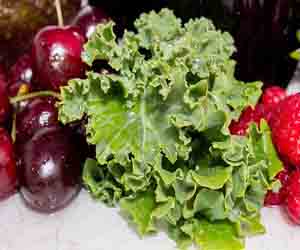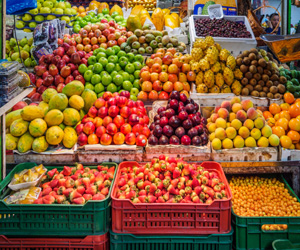


A Journey To Wholesome Eating

In a world dominated by processed and convenience foods, the concept of real food has become a beacon of hope for those seeking a healthier, more authentic way of nourishing themselves. Real food, often referred to as whole food, represents a return to the basics, embracing unprocessed, natural, and minimally refined ingredients. This article delves into the essence of real food and why it is gaining prominence as a cornerstone of a health-conscious lifestyle.
Defining Real Food: Real food is, at its core, food in its most natural state. It includes whole fruits and vegetables, lean meats, unprocessed grains, legumes, and minimally refined foods. Real food is free from artificial additives, preservatives, and unnecessary processing, with the aim of providing the purest form of nutrition.
The Real Food Movement: The real food movement is gaining momentum as people become more health-conscious and seek to reclaim control over their diets. This shift is influenced by several factors:
1. Health And Well-Being: The health benefits of consuming real food are well-documented. It can help manage weight, lower the risk of chronic diseases, and improve overall well-being. By consuming nutrient-dense, real food, individuals can support their health goals and optimize their vitality.
2. Transparency And Label Reading: As consumers become more label-conscious, they are paying closer attention to ingredient lists. This heightened awareness has driven demand for products that are free from artificial additives, and as a result, real food options have become increasingly popular.
3. Sustainability: Real food is often closely linked to sustainable and ethical agricultural practices. By choosing real food, consumers can support responsible farming and contribute to a more environmentally friendly food system.
4. Nutrient Density: Real food is inherently rich in essential nutrients, vitamins, and minerals. It offers more nutritional value per calorie, making it a sensible choice for those looking to optimize their diets.
The Benefits Of Real Food:
Consuming real food offers numerous benefits, including:
1. Nutritional Value: Real food is packed with essential nutrients, providing a wealth of vitamins, minerals, and antioxidants that support overall health.
2. Weight Management: Real food is often lower in calories and higher in fiber, promoting satiety and aiding in weight management.
3. Better Digestion: The fiber in real food supports healthy digestion and helps maintain a balanced gut microbiome.
4. Enhanced Flavor: Real food is renowned for its natural, unadulterated flavors. It enhances the culinary experience, making meals more enjoyable.
5. Improved Mental Health: Some studies suggest a connection between real food consumption and improved mental well-being. Nutrient-rich diets can positively impact mood and cognitive function.
How To Embrace Real Food: Incorporating real food into your diet is an achievable and fulfilling endeavor.
Here are some practical steps to get started:
1. Whole Foods: Prioritize whole, unprocessed foods like fruits, vegetables, whole grains, and lean proteins. These form the foundation of a real food diet.
2. Label Scrutiny: Read labels carefully, and choose products with minimal ingredients and no artificial additives.
3. Cooking At Home: Preparing meals at home allows you to have complete control over the ingredients and cooking methods.
4. Farmers' Markets: Visit local farmers' markets to access fresh, seasonal, and locally sourced real food options.
5. Mindful Eating: Adopt mindful eating practices by savoring the flavors and textures of your meals and paying attention to hunger and fullness cues.
Real food is a celebration of simplicity and authenticity in a world inundated with processed options. Embracing real food is a holistic approach to nourishing the body and the soul, offering a path to better health, greater sustainability, and a deeper connection to the origins of our sustenance.


The Art Of Ingredient Substitutions
 All-Purpose Flour: If you're out of all-purpose flour and need a substitute for baking, you can use alternatives like almond flour, coconut flour, or oat flour, depending on the recipe.
All-Purpose Flour: If you're out of all-purpose flour and need a substitute for baking, you can use alternatives like almond flour, coconut flour, or oat flour, depending on the recipe.
Sugar: For a healthier alternative, you can replace refined sugar with options like honey, maple syrup, or coconut sugar.
Butter: When a recipe calls for butter, you can use alternatives like coconut oil, olive oil, or unsweetened applesauce, depending on the application.
Heavy Cream: To replace heavy cream in savory dishes, you can use ingredients like Greek yogurt, silken tofu, or a mixture of milk and butter. For desserts, coconut cream can be a suitable alternative.
Healthier Ingredient Substitutions
Ingredient substitutions aren't just about convenience; they can also be used to make your dishes healthier. For example:
White Rice: Swap white rice for brown rice, quinoa, or cauliflower rice to increase fiber content and boost nutritional value.
Mayonnaise: In salads and sandwiches, you can replace mayonnaise with Greek yogurt for a lower-fat alternative.
Breadcrumbs: Instead of breadcrumbs, you can use crushed nuts or rolled oats for a gluten-free option in recipes.
Dietary Restrictions And Allergies
Ingredient substitutions are especially crucial for individuals with dietary restrictions and allergies. For those with gluten allergies, there are many gluten-free flours and starches available. People with lactose intolerance can use lactose-free milk or dairy-free alternatives. Those with nut allergies can often substitute seeds, such as sunflower or pumpkin seeds, for nuts in recipes.
Essential Tips For Success
 2. Start With Whole Foods
2. Start With Whole Foods
The foundation of a gluten-free lifestyle is natural, unprocessed foods. Fresh fruits and vegetables, lean proteins, and unprocessed grains like rice and quinoa are naturally gluten-free. These foods should form the basis of your diet, providing you with essential nutrients and fiber.
3. Experiment With Gluten-Free Alternatives
There's a wide variety of gluten-free alternatives available for the bread, pasta, and baked goods you love. Try different gluten-free flours, such as rice, almond, and coconut flour, in your recipes. Experiment with gluten-free pasta made from corn, rice, or quinoa. Over time, you'll discover which products and brands you prefer.
4. Beware Of Cross-Contamination
Cross-contamination is a significant concern for people with celiac disease. Even trace amounts of gluten can trigger symptoms or damage the small intestine. To prevent cross-contamination, create a designated gluten-free area in your kitchen. Use separate utensils, cutting boards, and cookware for gluten-free cooking, and always be cautious when dining out. Communicate your dietary restrictions clearly to restaurant staff.
Nourishing The Planet And Ourselves
 Local And Seasonal Sourcing: Embracing local and seasonal food is another pillar of food sustainability. The transportation of food over long distances generates a substantial carbon footprint. Choosing local and seasonal ingredients reduces greenhouse gas emissions and supports local economies. It also encourages consumers to connect with the natural rhythms of their environment and enjoy a wider variety of fresh, in-season produce.
Local And Seasonal Sourcing: Embracing local and seasonal food is another pillar of food sustainability. The transportation of food over long distances generates a substantial carbon footprint. Choosing local and seasonal ingredients reduces greenhouse gas emissions and supports local economies. It also encourages consumers to connect with the natural rhythms of their environment and enjoy a wider variety of fresh, in-season produce.
Reducing Food Waste: Food sustainability also involves reducing food waste, a significant problem worldwide. By minimizing waste at all stages of the food supply chain, from production to distribution and consumption, we can alleviate the strain on resources and landfills. This requires better planning, innovative packaging, and a shift in consumer behavior.
Healthy Eating: Healthy eating is an integral component of food sustainability. A diet based on nutrient-dense, minimally processed foods contributes to overall well-being and longevity. Sustainable food choices often align with healthier eating patterns, emphasizing fruits, vegetables, whole grains, and lean proteins.




A Taste Of Wholesome Goodness
 Transparency And Trust: Farm-fresh foods often come with a story. You can meet the farmers and producers, learn about their practices, and even visit the farms. This transparency fosters a sense of trust and a deeper connection to the food you eat.
Transparency And Trust: Farm-fresh foods often come with a story. You can meet the farmers and producers, learn about their practices, and even visit the farms. This transparency fosters a sense of trust and a deeper connection to the food you eat.
Support For Local Communities: By choosing farm-fresh, you are not just savoring great taste; you're also supporting local communities and economies. Small-scale farmers and producers often rely on local sales, and your patronage helps ensure their livelihood.
Environmental Impact: Farm-fresh foods typically have a smaller carbon footprint. Shorter transportation distances mean fewer emissions, contributing to a more sustainable food system.
How To Embrace Farm-Fresh Living:
Visit Local Farmers' Markets: Farmers' markets are a treasure trove of farm-fresh produce and artisanal products. They offer a chance to interact directly with the people who grow or make your food.
A Culinary Journey Through Your Backyard
 Flavorful Benefits:
Flavorful Benefits:
One of the most immediate and compelling benefits of homegrown flavors is the enhancement of taste. Here are a few reasons why homegrown produce tastes better:
Ripeness: Homegrown produce is harvested when it's perfectly ripe, ensuring that you experience the fullest, most vibrant flavors.
Nutrient Density: The time and care you invest in your homegrown produce can lead to higher nutrient content, contributing to more intense and wholesome flavors.
Variety: You have the freedom to choose a wide variety of fruits, vegetables, and herbs that may not be available at your local grocery store, diversifying your palate.
Unique Varietals: Experimenting with different heirloom or unusual plant varieties can lead to exceptional and distinctive flavors that are hard to find elsewhere.
A Sustainable Choice: Homegrown flavors align with the principles of sustainability and environmental responsibility. When you grow your own produce, you reduce your carbon footprint, as there are no transportation or packaging requirements.
A Recipe For A Better Tomorrow
 Supporting Local Farmers: By choosing locally sourced products, we bolster the livelihood of farmers in our communities. These farmers often employ sustainable farming practices, which protect the environment while producing high-quality, fresh food. Supporting local agriculture helps to keep family farms in business, preserving the rural way of life and ensuring a reliable source of food close to home.
Supporting Local Farmers: By choosing locally sourced products, we bolster the livelihood of farmers in our communities. These farmers often employ sustainable farming practices, which protect the environment while producing high-quality, fresh food. Supporting local agriculture helps to keep family farms in business, preserving the rural way of life and ensuring a reliable source of food close to home.
Reducing Environmental Footprint: Transporting food over long distances generates a significant carbon footprint. Local and sustainable choices mean that the journey from farm to table is shorter, reducing the environmental impact of our food consumption. Additionally, sustainable farming practices, such as organic farming and regenerative agriculture, minimize the use of harmful chemicals and prioritize soil health, further lessening environmental harm.
Preserving Biodiversity: Local and sustainable agriculture often focuses on heirloom and traditional varieties of crops and livestock. This helps preserve biodiversity, ensuring that unique and heritage breeds and plant varieties continue to thrive. Maintaining a diverse range of species is crucial for resilience in the face of pests, diseases, and changing climate conditions.